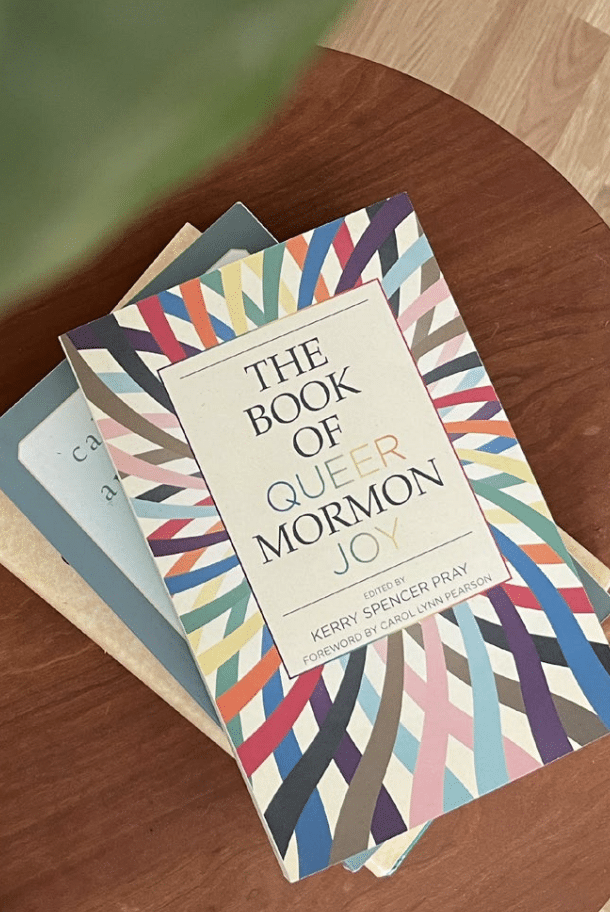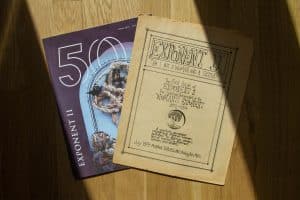The Book of Queer Mormon Joy (Signature Books, 2024) is a collection of stories by queer current, former, and adjacent LDS people. Carol Lynn Pearson writes in the foreword, “Yes, history moves slowly. But it does move . . . Indeed, we are at a place in history in which we can hear queer people tell their own stories, and we believe them, knowing that — like everyone else in the human family — our gay, trans, and queer members ‘are indeed that they might have joy!’”
Kerry Spencer Pray edits the collection and organizes the stories into three categories: Joy is Complicated, Joy is Defiance and Faith, and Joy is Gratitude for Home. She begins each section with a part of her own story, “To Dance in the Dim Light: Meditation on Joy.” This extended story connects and seamlessly introduces the three types of joy, inviting the reader on Pray’s own journey of discovering her sexuality, surviving cancer, meeting the love of her life, and creating her own family.
I was particularly moved by Allyson Verona Turner’s honesty in her experience of feeling joy in the essay “Summer of the Moths,” which chronicles the relationship with a woman beginning from online chatting through a dating app, a full-blown summer romance, and the bittersweet end at the start of September. “I’m not very good at joy; it’s not an emotion my body knows how to feel. Loud emotion is too much for my fragile body to carry. I like quiet emotions: peace, serenity, blissful happiness filling up my being the way a fresh mug of tea warms my hands on an autumn evening. I like to sit in silence and watch the sunset over the trees, the clouds change color and shape with the wind, the bats come out to weave their music across the twilight sky. I like moments where I can forget everything else — moments of distracted bliss.”
[This book] is a collection of stories by queer current, former, and adjacent LDS people.
This collection includes 36 pieces of writing, not all of which are essays. The goal of the book appears to be inclusivity and representation over a cohesive, homogeneous form or medium. While there are informative personal essays, uplifting personal accounts of public acceptance, and gut-wrenching narratives of rejection and shame endured when living one’s truth, there are a handful of entries that read as entries in a notebook, as disorienting streams of consciousness, or as fragments akin to poetry — forms we would typically think of as confined to private records.
The most impressive part of this collection is the variety of queer experiences represented. There are a number of essays for each letter in the LGBTQ+ alphabet, including less represented individuals and relationships — pansexuality, asexuality, and nonmonogamy. Additionally, much like the current population of the Church, the spectrum of relationship to Mormonism is beautifully represented in ways that are incredibly touching, shocking, and comforting to read. Erran Speaker’s “A Revelation” narrates her experience visiting a ward in Utah as a trans woman, nervously attending an unfamiliar Relief Society, her pleasant surprise of being warmly welcomed by fellow sisters, and listening to a lesson which seemed uniquely chosen for her: “No matter who we are or what we have been through, we are all needed individually.’ The opening caught me off guard, and for a moment I wondered if our teacher was trying to use inclusive language deliberately because we were there. But no, she was speaking to everyone present. And the sisters responded from the depths of their hearts.”
In another unique account of an individual’s queerness and faith, Alma Frances Pellett reflects on personal revelation received in the celestial room of the temple which guided and confirmed her decision to fully transition: “‘I will trust in their plan for me.’ I felt a wave of love deep into my soul. My tears changed from fear to relief. It was still dark and unknown ahead, but it would be okay. I am a daughter of my Heavenly Parents. I gathered myself together and made my way out of the temple with my reaffirmed confidence, likely never to return.”
The Book of Queer Mormon Joy is an exciting anomaly in literature and a wonderful stepping stone toward a more robust representation of the many identities of God’s children.




